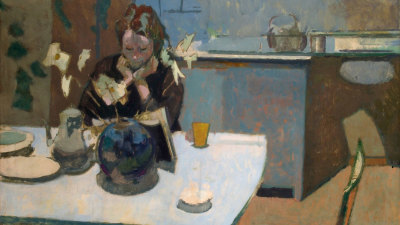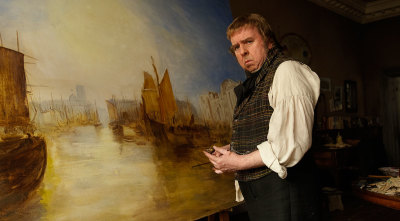Our pick of this week’s art events: 1 – 8 April
Our pick of this week’s art events: 1 – 8 April
By Daisy Schofield
Published 1 April 2016
From Doug Fishbone’s interactive mini golf course to a display of Dutch Flower Paintings of the Golden Age, we pick the week’s best art events.
-
John Latham: Spray Painting
Lisson Gallery, London, until 7 May
In this exhibition at Lisson Gallery, Latham’s spray paintings take centre stage, emphasising their significance in revolutionising his practice. Latham always challenged the modernist ideology: most famously, he organised a party to chew up and spit out Clement Greenberg’s book Art and Culture, the remnants subsequently placed into test tubes and returned to the St Martin’s School of Art Library.
Although less derisive, spray painting may still be perceived as an act of defiance – renouncing the picture plane that contemporary practice had rigorously conformed to. By spraying the canvases for a definite period of time, Latham’s spray paintings serve as a visual manifestation of his ‘event structure’ theory: the idea that all things in existence may be thought of as ‘events’ of different durations. In spite of this perplexing philosophical underpinning, the colourful and playful paintings are some of Latham’s most readily appreciable.
-

John Latham, Installation View, 2016.
©The John Latham Foundation; Courtesy of Lisson Gallery Photography: Jack Hems.
-
Dutch Flowers
National Gallery, London, until 29 August
This exhibition at the National Gallery celebrates flower paintings of the Dutch Golden age, a time when Still Life – a genre typically relegated to the very bottom of the art historical hierarchy – flourished. Still lifes were favoured at this time for their ability to convey moral meaning without committing idolatry: a sin heavily warned against in Protestantism. Dutch artists used flower paintings not only to dwell on the temporality of life, but also to demonstrate an astounding technical proficiency. Don’t miss the opportunity to stand before works by some of the Great Dutch Masters – Jan Brueghal the Eldger, Ambrosius Bosschaert and Roelandt Savery – and marvel at the extraordinary level of painterly detail.
-

Jans Van Olbricht, Still Life with Tulips, Chrysanthemums, Narcissi, Roses, Irises and other Flowers in a Glass Vase, 1608-1610.
Oil on copper Panel. 35 × 25.2 cm. Private Collection, Hong Kong.
-
Doug Fishbone: Leisure Land Golf
New Art Exchange, Nottingham, until 19 June
Doug Fishbone’s installation, originally commissioned for the 56th Venice Biennale, playfully navigates visitors through a mini golf course, which features the work of a multitude of artists, from Yinka Shonibare RA to John Akomfrah OBE, Hetain Patel to Lindsay Seers, alongside Fishbone himself. Dissolving the barriers between the viewer and the art object, the imaginatively designed golf course is reliant on audience participation not only to keep the ball rolling, but also to provoke thought. The golf course as a leisurely symbol of consumerist society serves as a counterpoint to issues relating to migration, global warming and globalisation that eventually come to the fore. Highlights include Shonibare’s mushroom cloud comprised of footballs decorated with African textiles. The piece draws parallels between the pitch and a migrant’s struggle for economic survival, playing not only for himself, but also for his team.
-

Yinka Shonibare RA, Football Cloud, 2015.
Image Credit Theirry Bal.
-
Shelagh Wakely: Spaces in Between Things
Richard Saltoun, London, until 13 May
Encompassing elements of architecture, installation, painting and drawing, Shelagh Wakely’s work is difficult to categorize. About as rich and varied as her artistic output was her background: born in the small town of Madingley, Cambridge, Wakely later moved to Kenya and continued to build global relationships throughout her life, later collaborating with Brazilian artists Lucia Nogueira and Tunga. As a young student, she studied agriculture, however she soon turned her attention toward the arts, studying screen-printing and painting and subsequently working as a textile and clothing designer. A concern with surface texture, organic shapes and the ephemeral are a consistent feature of Wakely’s work, as embodied by the beautifully delicate Spring Snow (1986), a floor installation made entirely of coloured tissue paper. This truly imaginative artist deserves well overdue recognition.
-

Shelagh Wakely, Spring Snow installation at Drawing Room, Rosebery Avenue, 1986.
Photo collage. 34.5 x 28 cm. Copyright the Estate of the Artist. Courtesy Richard Saltoun Gallery.
-
Slim Aarons: Poolside
Getty Images Gallery, London, until 7 May
This exhibition of Slim Aarons’ photography transport us back to the dreamy, serene Californian summers the artist spent in the company of high society following the Second World War. Previously enlisted by the U.S. Army as a combat photographer, Aarons’ photo of beautiful people in a state of bliss and luxury are antithetical to what the artist would have borne witness to in his past occupation. This idealised vision of America is a visually enticing look at life spent by the poolside.
-

Slim Aarons, The swimming pool of the Hotel Camino Real in the resort city of Puerto Vallarta, Jalisco, Mexico, 1979.
Slim Aarons/Getty Images.








